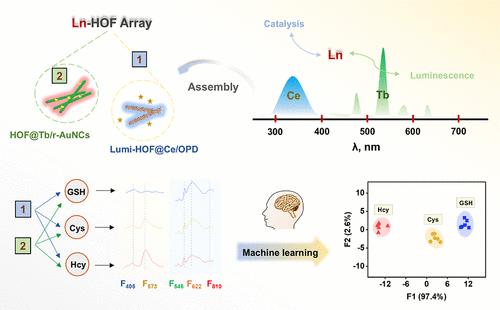基于hof的逻辑门传感器阵列用于生物硫醇检测和疾病鉴别的镧系元素辅助功能裁剪
IF 6.7
1区 化学
Q1 CHEMISTRY, ANALYTICAL
引用次数: 0
摘要
具有靶向发射响应和低自荧光干扰的镧系指纹传感器检测生物硫醇的进展对癌症的早期诊断和治疗具有相当重要的意义。本文设计了镧系元素“个性功能定制”HOF复合传感器阵列,用于通过HOF表面接近激活各种发光分子(如r-AuNCs/luminol)来特异性识别生物硫醇(GSH, Cys和Hcy)。Lumi-HOF@Ce作为一个多功能平台,催化邻苯二胺(OPD)氧化生成黄色荧光低聚物,伴随发光氨的荧光衰减。HOF@Tb作为一个约束界面,聚集具有红色荧光的金纳米团簇(r-AuNCs),促进聚集诱导的发射增强(AIEE)。生物硫醇中的Au(I)-硫酸基序在增强的配金属电荷转移(LMCT)过程中对aunc的荧光特性产生不同程度的影响。此外,Lumi-HOF@Ce的催化活性表现出类似氧化酶的性质,不同的生物硫醇可以不同程度地抑制其催化活性。在机器学习算法的帮助下,五通道荧光阵列展示了对生物硫醇指纹的卓越辨别。特性定制的镧系HOF传感器阵列使用逻辑门策略,在临床肝癌样本与正常样本的分类中实现了接近100%的灵敏度识别。当前的镧系元素功能定制策略提高了生物传感应用的适用性。本文章由计算机程序翻译,如有差异,请以英文原文为准。

Lanthanide-Assisted Function Tailoring of the HOF-Based Logic Gate Sensor Array for Biothiol Detection and Disease Discrimination
The advancement of lanthanide fingerprint sensors characterized by targeted emission responses and low self-fluorescence interference for the detection of biothiols is of considerable importance for the early diagnosis and treatment of cancer. Herein, the lanthanide “personality function tailoring” HOF composite sensor array is designed for the specific discrimination of biothiols (GSH, Cys, and Hcy) based on the activation of various luminescent molecules, such as r-AuNCs/luminol via HOF surface proximity. Lumi-HOF@Ce serves as a versatile platform for catalyzing the oxidation of o-phenylenediamine (OPD) to generate yellow fluorescent oligomers, accompanied by the fluorescence attenuation of luminol. HOF@Tb functions as a confinement interface that gathers gold nanoclusters (r-AuNCs) with red fluorescence, facilitating an aggregation-induced emission enhancement (AIEE). The fluorescence properties of AuNCs are subsequently impacted to varying degrees by the Au(I)-thiolate motifs from biothiol rooted in an enhanced ligand–metal charge transfer (LMCT) process. Additionally, the catalytic activity of Lumi-HOF@Ce, which exhibits oxidase-like properties, can be inhibited by different biothiols to varying extents. The five-channel fluorescent array demonstrates exceptional discrimination of biothiol fingerprints, aided by machine learning algorithms. Feature-tailored lanthanide HOF sensor arrays achieve sensitive identification with nearly 100% accuracy in classifying clinical liver cancer samples versus normal samples, using a logic gate strategy. The current strategy of lanthanide function tailoring boosts the suitability of biosensing applications.
求助全文
通过发布文献求助,成功后即可免费获取论文全文。
去求助
来源期刊

Analytical Chemistry
化学-分析化学
CiteScore
12.10
自引率
12.20%
发文量
1949
审稿时长
1.4 months
期刊介绍:
Analytical Chemistry, a peer-reviewed research journal, focuses on disseminating new and original knowledge across all branches of analytical chemistry. Fundamental articles may explore general principles of chemical measurement science and need not directly address existing or potential analytical methodology. They can be entirely theoretical or report experimental results. Contributions may cover various phases of analytical operations, including sampling, bioanalysis, electrochemistry, mass spectrometry, microscale and nanoscale systems, environmental analysis, separations, spectroscopy, chemical reactions and selectivity, instrumentation, imaging, surface analysis, and data processing. Papers discussing known analytical methods should present a significant, original application of the method, a notable improvement, or results on an important analyte.
 求助内容:
求助内容: 应助结果提醒方式:
应助结果提醒方式:


